
|   |

|   |
Hirakud Mahotsav - Tapati Chowdhurie e-mail: tapatichow@yahoo.co.in Photos courtesy: Aruna Mohanty April 21, 2023 The long wait of aficionados for a beautiful festival of dance at Hirakud's sylvan surroundings, was at last made possible with the coming together of Odia Language Literature and Culture Department, Government of Odisha, Odisha Sangeet Natak Akademi, District Council of Culture, Sambalpur and Sambalpur Municipal Corporation. Hirakud, the 20th century mystery of the longest earthen embankment in the world was a fitting setting for Hirakud Mahotsav. Jawahar Udyan was the chosen venue. It is expected that the Hirakud Festival will be a permanent annual festival of the marvel that is Odisha. 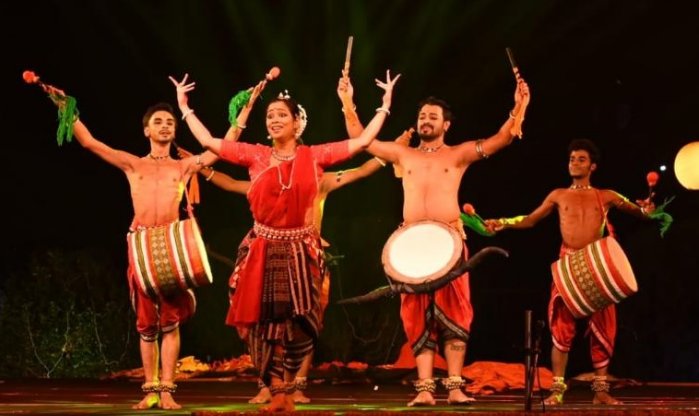 Sharmila Biswas's group OVM Be it the Konark Festival or the Dhauli Kalinga Festival, Odisha has always celebrated the various dance forms of India, while not neglecting their very own Odissi dance. Each day of every festival prime time is given for Odissi alongside any one of the classical dance forms of the country. With that aim in view, on the first day of the three-day festival, famed Odissi exponent Sharmila Biswas's repertory members presented some of her dance compositions. Her creations were unique. The Artistic Director of Odissi Vision and Movement Centre, Kolkata, one of the prime cultural institutions of India, Sharmila Biswas has worked hard tracing the many facades of traditional performing arts of Odisha, and has viewed Odissi dance and its intrinsic links with its roots, which have been the foundation of many of her productions. Sharmila's association with Sambalpur began with Kalaparishad in 2000. With the guidance of Murari Misra, Ghasiram Misra, Dukhishyam Tripathy, she studied the dance and music traditions of Sambalpur. This study has enhanced her views, and helped her to create many new productions. As a student of Odissi dance she found it important to keep in touch with the old traditions of Odisha. Inspired by her study, she had choreographed Amit-Shrishti and Dhulikhel, with a team of artistes from Sambalpur led by Sasankasekhar Dubey and Chandrasekhar Dubey. In her first performance at Hirakud Mahotsav, she presented pieces inspired by the dance and music of Sambalpur. In 'Devi Bharani,' a group of drummers invoked the spirit of the Goddess Sambaleswari. Considering the fact that the reigning deity of Sambalpur is Ma Sambaleswari, the opening dance was a fitting piece to launch the festival. However the giant sized presence of the deity in the background, noteworthy for its awe-inspiring presence gave the piece a folkish element. A group of drummers invoked the spirit of the Devi through the body of a medium. This mystic and spectacular ritual of the spirit of the Devi rising added to its quaintness. Monami Nandi was an epitome of one possessed, besides being a good dancer and so are the others in Sharmila's team. The piece 'Khel' was vibrant and expressive using the rhythm patterns of Sambalpuri dance. Khel presented a collection of rhythms danced in the fashion of a game of sawal-jawab (question-answer), innovatively presented through the game of Kabaddi between two teams. 'Rupantar' consisted of a profusion of Sambalpuri dance movements. It was her attempt to evolve movements of the Odissi dance form with the spontaneity of the Sambalpuri dance genre. A rather innovative piece, Rupantar was a lively and joyful piece preceding 'Ananda Moksha' or salvation choreographed by Sharmila. In these movements of joyous processions, the vigour and grace of Shiva-Shakti dancing, the traditional rhythms of ghanta mardala, accompanied by recitations were the highlights. 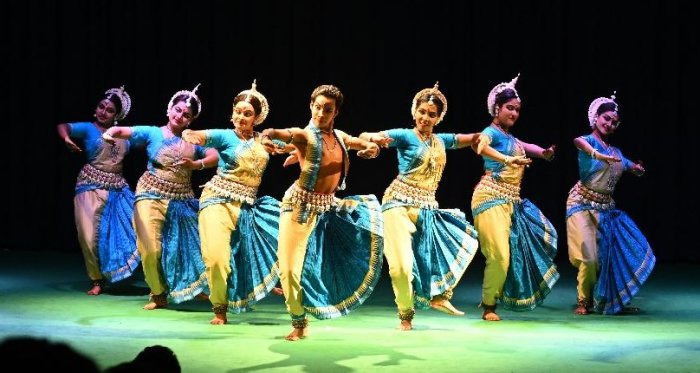 Jyotsna Rani Sahoo's group Soor Mandir's presentation in Hirakud Mahotsav on the second day was 'Shree Ram', an avatar of Lord Vishnu, about the challenges faced by the offspring of Kaushalya and Dasharatha. The oft performed theme had a uniqueness in the hands of the choreographer Dr. Jyotsna Rani Sahoo and music composer Swapneshwar Chakraborty. Kirti Kalabati Pallavi put to test the dancers' ability in the rendition of pure dance. Slow, graceful and lyrical movements of the eyes, neck, torso and feet slowly built to a crescendo and then to climax in a fast tempo at the end. Guru Sachidananda Das, the master of rhythm, did an excellent job. 'Sri Ranga Charana' paid homage to Vishnu by way of reverence paid to his lotus feet as per old tradition. It symbolised dedication to the Lord. The dance-drama was all about the devotee's total surrender to the Almighty. 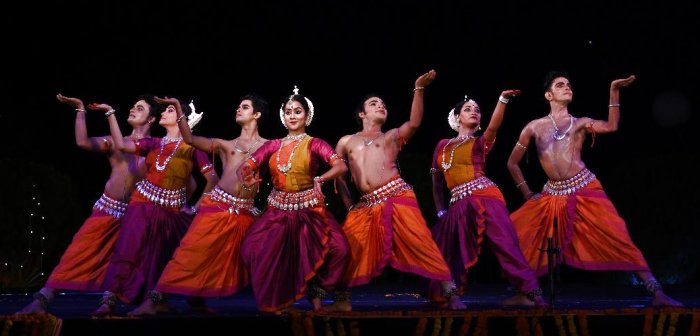 Bichitrananda Swain's group Bichitrananda Swain is one of the finest choreographers of Odissi dance who makes temple sculptures and paintings of mythological characters skilfully traverse through space and time and create visual grandeur. In his hands, a riot of sculptures comes alive on stage. This time he had a mixed group of male and female dancers perform 'Chandrika Kamodi Pallavi' in ek taali . And then came the invocatory piece 'Maha Kali Stuti' lending itself to high drama of blood and gore. Physical description of Mahakali, adorned with a garland of human skulls, lent itself well to the vigour and boundless energy of the finely trained dancers. The rhythm of the dance itself was catchy swaying the audience like in an autumn breeze all through. 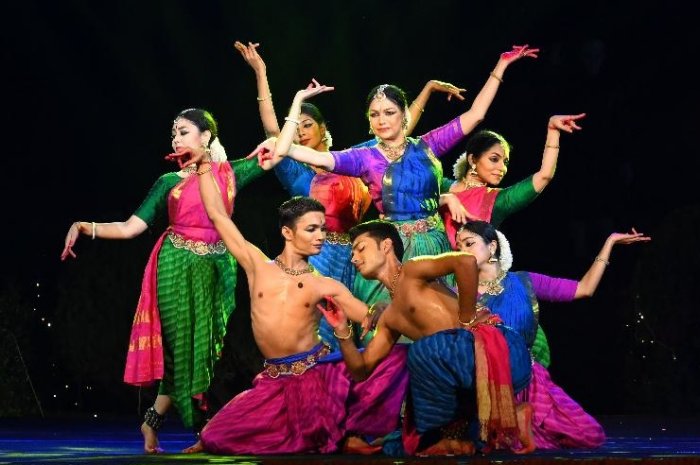 Rama Vaidyanathan and group Bharatanatyam dancer Rama Vaidyanathan's mature handling of the learnt genre has seen her evolve her own style which is widely acclaimed. The first piece 'Arise', though pedantic and sermonic, its ubiquitous influence was lost to none. It held promises. The importance of rising with the sun was duly emphasized, just as collecting one's thoughts by way of prayers to the omnipotent Siva is. Different early morning symbols and their exposure through dance delighted the dance lovers. "Wake up from the slumber of ignorance to spiritual consciousness" was the underlying message. The space covered by the dance units was impressive and the dance style mesmerised the audience. Changing positions were practised to perfection. The poem in Tamizh depicted a sense of togetherness in community building, where everyone without being self-absorbed is concerned about the well-being of another. Rama took the verses from Thiruvempavai written by Maanikkavaachakar. Music composition was by Sudha Raghuraman. However, the piece-de-resistance of the show was Swati Tirunal's 'Kashi.' The musical genius had written this piece urging his mind to undertake a pilgrimage to Kashi to have a vision of Lord Visveswara in order that he may be released from the cycle of birth and death. Rama and her repertory members traced the flow of the river Ganga flowing through the city like pure milk, on whose bank sages reside and the Lord smeared with holy ash shares his form with the daughter of the mountains. The procession and delineation of every line in a realistic manner transported the dance loving audience to Kashi in the mind's eye. Being an ardent devotee of Padmanabhaswami, he urges his mind to worship the lord's lotus feet. The touching and intensely devotional piece took the audience to a higher level of spiritual consciousness. Kashi at once showcases both creation and dissolution. Each one is led to discover his true self. Rama's many examples came to one conclusion that Kashi symbolises a state of mind that we all yearn to reach.  Shama Bhate's group The venue of the festival on the second day of the Mahotsav had to be shifted from the beautiful open air make-shift theatre to the proscenium stage of Sambalpur University due to inclement weather followed by torrential rain. Nad-Roop therefore made their presentation of 'Umang' on the proscenium stage. Through 'Shivashtakam,' disciples of Shama Bhate invoked Shiva - the Creator and the Destroyer - the cause of this universe. Breathing life unto all living beings on earth with the sound of his damaru while seated in meditation on mount Kailasa, was in the language of flawless Kathak. His physical description lent itself to aesthetic beauty. The poses and easy stylised movements of the dancers as they described his adornment with serpents, his eyes like golden flame, his neck as blue as a lotus in the water, still float before my eyes. The Shiva Vandana was followed by a Dhrupad in raag Adana. The spirit of Lord Shiva was worshipped and celebrated. It brought to life the dance of Lord Shiva through the dynamism of Kathak in all its varied history. Basant Tarana of the Gwalior gharana was the penultimate number, where the vibrancy of Kathak was manifested beautifully and aesthetically. Intricate laykari and anagat compositions were woven seamlessly to elaborate the bandish. 'Hori Rang Darungi' was about Holi. When the whole of Brij is immersed in the colours of Holi, there is joy and mischief. One Gopi however wants to play with colours only with Krishna who is the prime mischief maker at all times. She says "Rang darungi Nand ke laalan pe"... The others teasingly retort, "You keep waiting for your beloved Krishna... We don't want to play with you either! We have our own plans - we'll play not just with colours, but even flowers and laddoos and what not!" This beautiful concept and choreography was by Shama Bhate while the music composition was by Kedar Pandit. Dancers Ameera Patankar, Avani Gadre, Bhargavi Sardesai, Esha Nanal, Shraddha Mukhade, Shreya Kulkarni, Prachiti Bhave, Savani Sahasrabuddhe, Pramod Wagh, Samhita Agaste put the stage on fire with their chakkars and pranks, quick movements, smearing of colours by the victims and victors thereby regaling the audience all through. 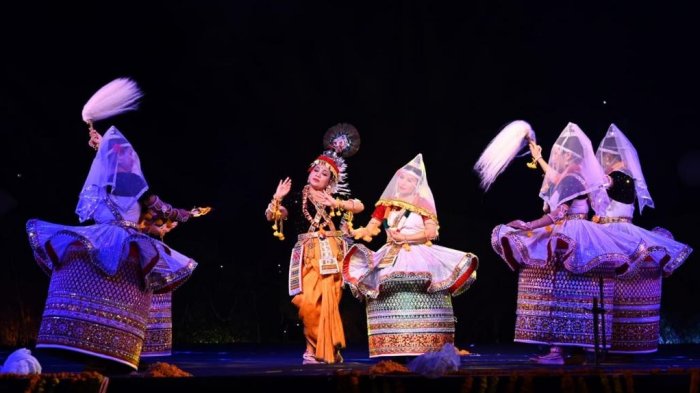 Priti Patel's group Manipuri dancer and Artistic Director of Anjika, Priti Patel presented her disciples in 'Yeningtha -The Magic of Spring' composed by the legendary Guru Amubi Singh and Guru Th Babu Singh. Dasavatar invoked the Avatars of Vishnu - the saviour of mankind whenever he is in need of it. The dance was composed in teental of 7 beats and Tanchep of 4 beats followed by Pung Cholom which is typical of Manipur; an excerpt from Sankirtana tradition of Manipur completed the piece. Finally they presented Vasanta Raas, the divine love play of Radha and Krishna with the gopis. Raas Leela is actually a prayer to Radha and Krishna and that is exactly how it was depicted. At the end of the dance, the deities of Radha and Krishna was prayed to by the gopis to the accompaniment of typical musical instruments of Manipur. The double conch blowing in the typical style of Manipur spelt a devotional aura engulfing the audience. The lyrics of this piece was taken from Kavi Jayadeva's Geeta Govinda-"Chandana charchita neela kalebara...". Here Krishna was shown in love dalliance with the gopis and together they celebrate the festival of spring with the play of flower petals. This beautiful piece was composed in taal Chautal of 12 beats, taal Tanchep of 4 beats, taal Menkup of 6 beats and taal Chali of 8 beats. S. Karuna Devi in the role of Krishna emerged as larger than life when the mood was one of bhakti. K. Ratan Singh and C. Bickram Singh created a perfect ambience with their pung cholom. Folk dances are the foundation of the stylised dances of the country. Duly recognizing its strength, the Mahotsav provided this prestigious platform to as many folk groups as it was physically possible. On each of the three days, the stage was made available to as many as three groups each evening. Ranjan Kumar Sahoo and his group from Sambalpur played traditional instruments dhol, nishan, tasha, dhap, khudka, khanjani, sanchar khol, samparda, nagra, mardal etc. of Western Odisha. The dance was based on playing the folk music of Deogarh, Bargarh, Sambalpur, Balangir, Kalahandi, Sonepur, Jharsuguda, Nuapadha, Boudh, and Angul. The Bastar Band of New Delhi headed by Anup Ranjan Pandey who is a versatile folk artist working for the development of Raasleela, one of the primitive Chattisgarhi folk, regaled the audience with their folk art form. J. Sukant and group of Rayagada danced the typical Dhemsa, performed by Kutia Kandh tribes during harvest times. Bhumi Ma is worshipped after harvest which is in December. At dusk, boys and girls play traditional musical instruments and dance together with rhythmical movements which are spontaneous and innovative and are their very own. 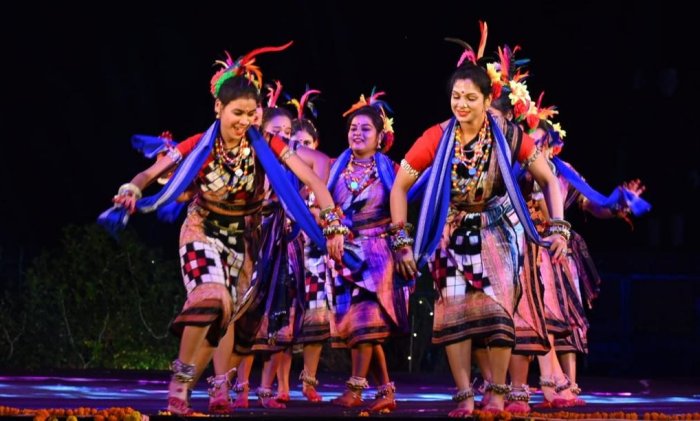 Basudev's group, Balangir  S Kshirod Dora and group from Ganjam Basudev and group Balangir performed Ghudka dance form, where the main artist played the Ghudka made of a hollow shaped light wood, one side of which is made of lizard skin with a middle string connection. The dance was colourful and rhythmical, danced with spontaneity. This dance style, like all other folk styles, has come down from generation to generation. Ghudka exhibited quick speed, graceful movements and artistic skills. S. Kshirod Dora and group performed Animal Mask Dance. Dummy animals made of cane and bamboo and profusely decorated with coloured velvet cloth worn by artistes enthralled the audience. It is used as a kind of fun entertainment for the people. 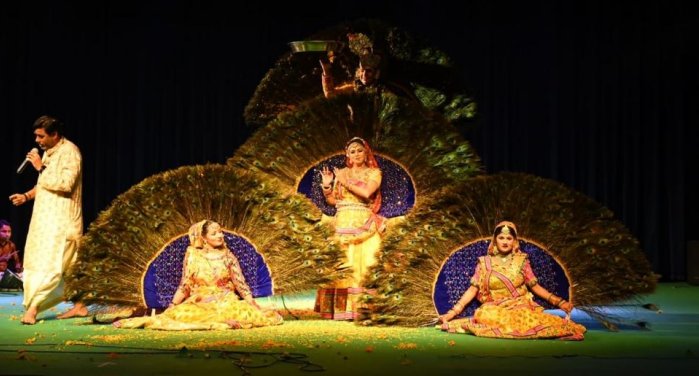 Mayur Rasa group from Jharkhand 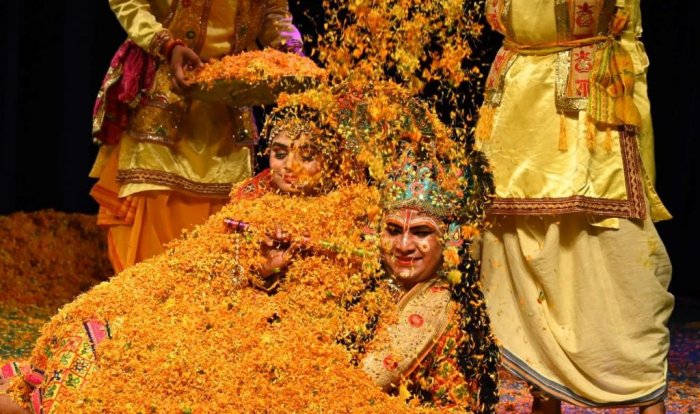 Mayur Rasa - Radha Krishna covered with flowers Mayur Rasa by internationally famed Sanjay Sharma with his group from Jharkhand performed Charkula. Veneration of the divine couple Radha and Krishna by showering them with flower petals has perhaps no parallel. Radha and Krishna played Holi with flower petals, after which the gopis as well as aficionados from amongst the audience covered the divine couple with petal shower. There was great beauty in the whole performance. Rabindra Bag and group, Maa Samalei Nupurkala Parishad, Baragarh, performed Dan Nrutya in which goddesses are described in various traditional forms. The meanings of the various facets of Sambalpuri dance, its costumes were also described. 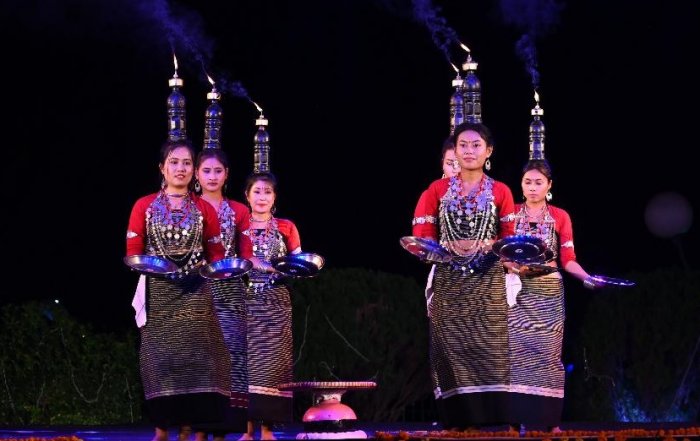 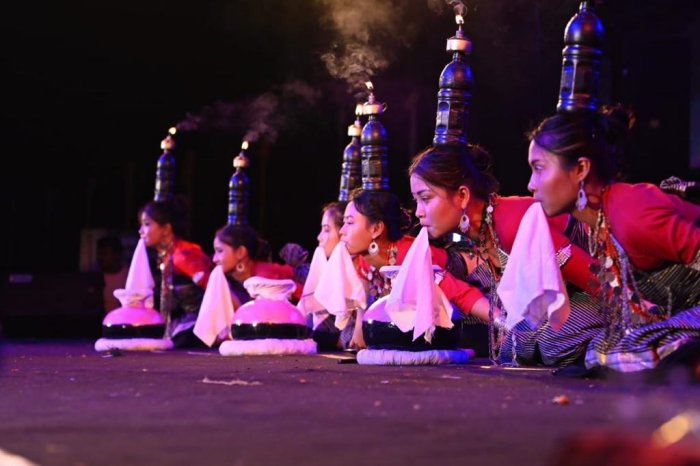 Hojagiri dancers from Tripura Parimal Debbarma and group Hojagiri, traced the origin of Hojagiri folk dance form of Tripura. In this performance it was possible to envision the entire lyric into minute details displaying each of its strength. In Hojagiri dance it was even possible to see the ant militia crawling towards the source with vigilant eyes and alert antennas, you could see the performers entering the scene like the clouds in a wave. Balancing the earthenware lamps, pitchers, bottles on their head with mairang in their hands, they danced a slow hip hop. This dance is performed on the occasion of Lakshmi Puja. The collective shone like the full silver on a dark black sky. It was a performance of a balancing act with graceful movements. 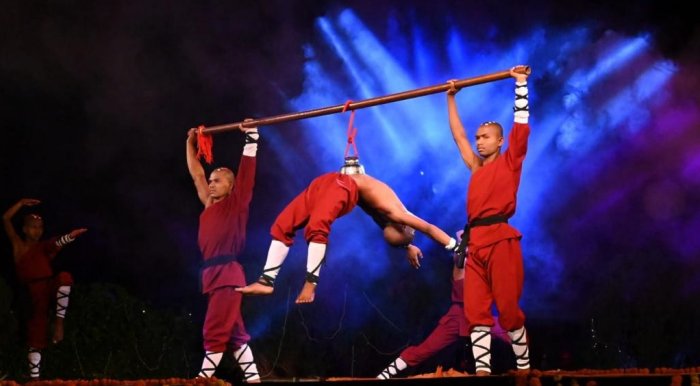 Binash Kumar Misra and group Malkangiri Binash Kumar Mishra, a young and dynamic person, serves society by practising martial art form as a mission. With his group Malkangiri, he covers a broad range of activities that involves fighting techniques, physical exercises and methods of mental discipline, among other skills. Through martial arts, he brings about spiritual enlightenment by following a middle path. His Martial Art choreographic work was excellent. The rich folk dances of India need to be patronised more for our own good.  Tapati Chowdhurie trained under Guru Gopinath in Madras and was briefly with International Centre for Kathakali in New Delhi. Presently, she is a freelance writer on the performing arts. |